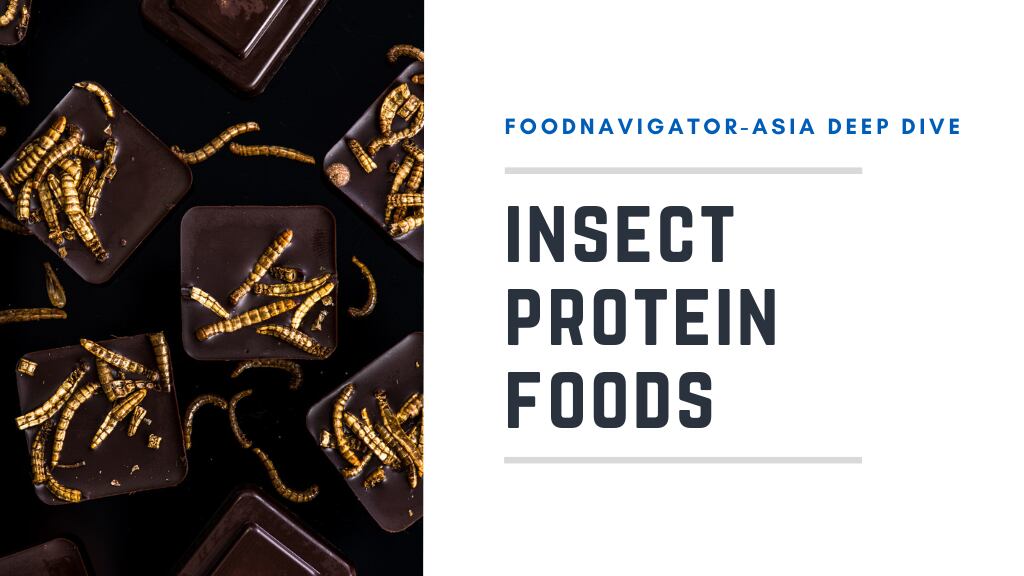In this edition of the FNA Deep Dive, we take a look at how strong the potential for the insect-based protein foods sector is in the region and assess major challenges that might stand in the way of it becoming a mainstream food source.
At a glance, the numbers for the sector look promising, with a global market value of US$143.6mn and a projected 45% CAGR. Support from the mainstream F&B industry has also been strong, with many having invested in start-ups specialising in alternative insect-based protein sources.

One such example is Thai seafood firm Thai Union, which announced an investment into fruit-fly protein start-up Flying SpArk last year to help with R&D activities as well as how to scale up production.
“We are currently running pilots at small scale with a number of food companies like Nestle and Bimbo Group, and now are just waiting to scale up,” Flying SpArk CEO Eran Gronich told FoodNavigator-Asia.
“Another important area to look at will be cost reduction, as cost of production is currently still quite high. [Thai Union] is one of the biggest in the region for tuna and seafood products, and are experts at manufacturing and the entire chain – we hope to learn from them in terms of setting up production, cost reduction, strategy and the like.”
Gronich was very positive about the future of insects as food in Asia, especially South East Asia as he claimed ‘consuming insects is already in the culture for consumers, and not culturally strange’ to local consumers.
This opinion was shared by cricket seasoning company Orchestra Provisions Founder Kate Stoddard, who described Asia as ‘forward-thinking’ in terms of insect protein consumption.
“[Asia is] at the forefront of insects as human food, animal feed and regenerative agriculture pioneering insects for human consumption fed with organic waste from other crops - This is of utmost interest because additional feed is not required, they can help with waste that is not useful for human nutrition,” she told us.
She added that entomophagy (insect consumption) is popular in Thailand, Cambodia, Vietnam, Philippines, and South Korea where it serves as a traditional and accessible protein source.
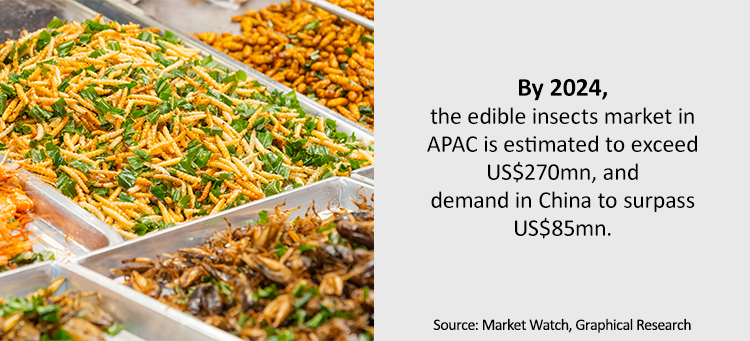
Founder of Cambodia-based insect snack company Bug Bacon Josh Galt also concurred with this view.
“Asia as a whole should be seen as the production centre for insects,” he said.
“The temperature is perfect and there are many smallholder farmers already farming insects here. Thailand is huge in this, and there are also many in Cambodia, Laos, Vietnam and so on.”
Based on consumption quantity, he added that China is most likely in the lead within the region, and insect protein consumption in the region will further increase if the global economy embraces entomophagy as a viable and honorable food source.
“If leading global economies and traditions embrace this industry, the entire world will have access and feel good about entomophagy as a staple practice,” he said.
The Bug Bacon product is made from black soldier grubs, with 65% protein and 16% fat, a naturally ‘chewy’ texture, and has plant-based vegan bacon seasoning to give the snack a mouth-feel and flavour similar to real bacon.
Watch the video below to find out more:
Acceptance not wide enough
Unfortunately, entomophagy’s traditional and cultural hold in Asia may not be enough to sustain the growth and development of an entirely new food sector, according to the Founder of Thailand-based Bugsolutely cricket pasta and China-based silkworm snack Bella Pupa Massimo Reverberi.
“Many people think Asia is the market to be when it comes to edible insects, but there are actually two very different worlds even within the countries where entomophagy is most popular,” he told FoodNavigator-Asia.
“For example in Thailand – eating insects is very common in the countryside, but not in the big cities like Bangkok’. Thai consumers are used to buying whole insects from street vendors – they are not going to pay for edible insect products that are packaged nicely and sold at a premium price.
“Insect-eating is more like a traditional cuisine, and mostly only applies to whole insects – not packaged, finished products like what most start-ups are trying to market today.”
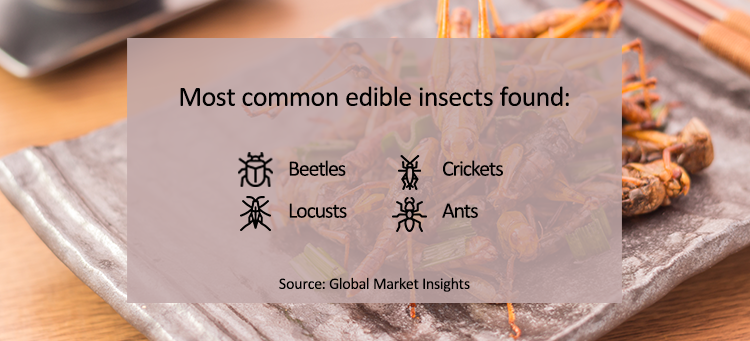
Reverberi added that in China, perhaps some 50% of the population finds eating insects normal, but again, this practice is not found in cities either.
In contrast, he believes that European consumers are actually far more advanced when it comes to accepting insect-based products, and the driving factor here is very much dependent on their viewing insects as a delicacy or superfood.
“Many Western consumers use insects as a ‘super-ingredient’ in foods such as breads, crackers, pastas chips and more, saying that it adds a good, nutty taste,” he said.
His aim is to market Bugsolutely’s cricket pasta to Europe instead of Asia as a primary target because of this, despite it being produced locally in Thailand.
Benefits – better than plant-based?
The main reason insects are considered to be superfoods is due to high protein and high mineral contents. For example, Reverberi revealed that crickets comprise of some 60% protein, a variety of minerals including calcium and potassium, omega-3, -6, -9, vitamins, fatty acids and very little carbohydrates.
“If a scientist were to come up with the design for the perfect type of meat, I believe that it would have a similar nutritional profile as insects. Even chicken cannot beat it,” he said.
“It also has an advantage over plant-based products, such as those from plant-based companies like Impossible and Beyond, as these go through a lot of processing and add in a lot of ingredients, and their protein extraction processes may result in food waste as well, unlike that of insect products.”
“More importantly, these are not superfoods, like insects are.”
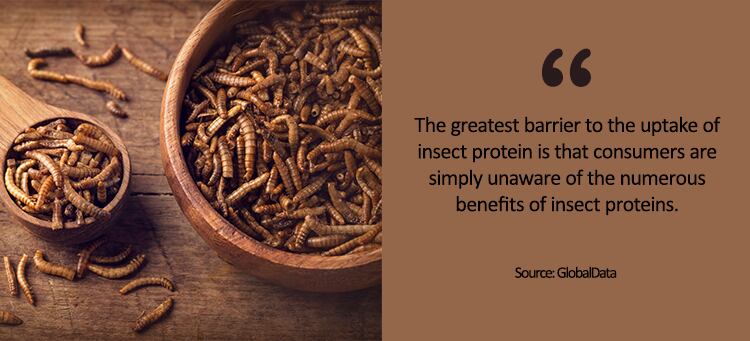
Stoddard seconded this, adding that every insect has a unique nutritional profile, for instance, beetles have more essential fatty acids, while mealworms and crickets have more protein.
“Crickets have gram to gram more protein than beef, more calcium than milk and more iron than spinach,” she said.
“The iron that crickets have is heme-iron, which is 90% absorbable in the gut when compared to non-heme which is 50%. Crickets also have plenty of B-vitamins, other minerals and prebiotic fiber for healthy gut flora.”
Another oft-cited reason for switching to insect consumption is sustainability, in which it beats even plant-based proteins as it does not require as much water, or arable land.
“Insect protein hybridises the positive aspects of animal protein and plant protein to make a more efficient alternative,” Stoddard added.
“If we can raise human food from human waste, crickets don’t require any additional feed. This may sound unattractive, but it is very conscious and viable, for example undigestible fibrous waste from the cassava or palm industries has the ability to yield highly nutritious cricket protein.”
To add to the health benefits of insect-based products, Orchestra Provisions is also looking at a therapeutic line of specialty powders to add to beverages (milk, milk substitute, smoothies) or as an ingredient for pancakes, oatmeal, and baking products. This would mean include blends with beneficial botanicals such as spirulina, ginger, beet and so on.
Challenges
That said, all the health and sustainability benefits in the world will not be sufficient to gain consumer acceptance if consumers feel disgusted when they see a product – a challenge Reverberi says is very real in the APAC region.
“Getting past consumers’ ‘ick’ factor is a very big thing here in Asia, especially in the developed cities,” he said.
“In Muslim countries, the halal status of insects really depends too – crickets are generally accepted as they are in the Quran, but worms are debated. There are 1.6 billion halal consumers in the region and even if there is a little bit of doubt, it is a limitation for them.”
However, he stressed that the regulatory challenges are an even bigger headache here in the region
“Many food agencies in Asia are very traditional or old-fashioned in their thinking, and not used to accepting food innovations so quickly,” said Reverberi.
“In China, silkworms are accepted as a novel food, but even then permits and certificates take very long to obtain and are very expensive. In places like India or South East Asia, most regulatory bodies don’t have much clue about this and tend to be surprised when we surface our products to them.”
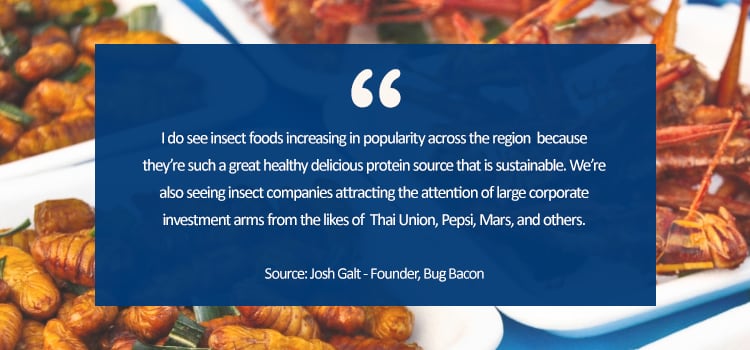
Galt was more optimistic about the insect consumption market in Asia, but told us that the main challenge for growth in Asia surrounds upward mobility and leaving the past behind, especially when people associate it with economic lack.
“So, the challenge in Asia will be convincing people they should re-adopt cultural food norms, which most in the growing middle class have shunned in favour of more meat-heavy diets,” he said.
On top of regular market challenges, the recent COVID-19 pandemic outbreak has hit the industry hard, with sales and operations hindered worldwide due to lockdowns and restriction orders.’
For example, Stoddard released her cricket-based seasonings in January this year via the Asia Insect Farm (AIFS) to much interest, but COVID-19 was disastrous for her business in Asia as well as the United States.
However, she believes that ‘the world will be as ready as ever to hear about sustainable food systems after the trauma we are experiencing now’.
Reverberi also told us that business ‘is at zero’ at the moment, especially as Thailand is in the midst of a lockdown with a curfew, making thing even more difficult for a business that very much depends on him travelling a great deal.
Future direction
He opted not to dwell on the sector’s market outlook for the next few years just yet due to the outbreak, but generally still feels that there is hope for insect-based foods.
“It might need some time, maybe even a few decades, but the world changes fast,” said Reverberi.
“With globalisation and information everywhere, the benefits of insects in terms of sustainability and nutrition will spread fast. It carries good messaging.”
Stoddard was even more optimistic, firmly believing that insect protein will become a global mainstream - the question is when.
“I imagine people are going to be more motivated to be a part of a positive change where food security and sustainable food systems are a conversation,” she said.
“As we start to grow as a population, meat will become less accessible and unrealistic to eat at every meal, so [insect protein will eventually take a market share away from meat].”


